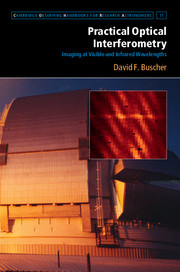Book contents
- Frontmatter
- Contents
- Principal symbols, functions and operators
- List of abbreviations
- Foreword
- Preface
- 1 Making fringes
- 2 Basic imaging
- 3 Atmospheric seeing and its amelioration
- 4 Interferometers in practice
- 5 Measurement noise
- 6 Interferometric observation of faint objects
- 7 Observation planning
- 8 Data reduction
- 9 Model fitting and image reconstruction
- Appendix A Fourier transforms
- Appendix B Supplementary online material
- References
- Index
Preface
Published online by Cambridge University Press: 05 August 2015
- Frontmatter
- Contents
- Principal symbols, functions and operators
- List of abbreviations
- Foreword
- Preface
- 1 Making fringes
- 2 Basic imaging
- 3 Atmospheric seeing and its amelioration
- 4 Interferometers in practice
- 5 Measurement noise
- 6 Interferometric observation of faint objects
- 7 Observation planning
- 8 Data reduction
- 9 Model fitting and image reconstruction
- Appendix A Fourier transforms
- Appendix B Supplementary online material
- References
- Index
Summary
Optical interferometry uses the combination of light from multiple telescopes to allow imaging on angular scales much smaller than is possible with conventional single-telescope techniques. It is increasingly recognised as the only technique capable of answering some of the most fundamental scientific questions in astronomy, from the origin of planets to the nature of the physical environments of black holes.
Interferometry is an established technique at radio and millimetre wavelengths, with instruments such as the VLA and ALMA being the workhorses at these wavelengths. The development of interferometry in the optical (which we take here to include both visible and infrared wavelengths) has lagged behind that of radio interferometry due both to the extreme precision requirements imposed by the shorter wavelengths and to the severe effects of the Earth's atmosphere. For many years, the use of optical interferometry for scientific measurements was limited to the specialists who designed and built interferometric instruments.
At the beginning of the twenty-first century, the first “facility” optical interferometers such as the VLTI, the CHARA array the Keck Interferometer came online, with the aim of broadening the use of interferometry to the wider community of astronomers who could use it as a tool to do their science. As part of this expansion, organisations in Europe and the USA began to hold summer schools to provide an introduction to the theory and practice of interferometry to astronomers new to the topic. A number of times after giving lectures at these schools, I have had students come up to me wanting to find out more about some ‘well-known’ interferometric idea that I have mentioned in my talk. Often I have had to reply that there is no one place in the literature which provides this further information.
- Type
- Chapter
- Information
- Practical Optical InterferometryImaging at Visible and Infrared Wavelengths, pp. xv - xviiiPublisher: Cambridge University PressPrint publication year: 2015



